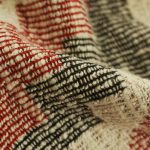You might recall how the ancient Greeks prized their linen robes for comfort in the heat—that same principle still guides us today when choosing what to wear on warm days. If you’ve ever wondered why some fabrics feel like a refreshing experience while others cling and trap heat, you’re not alone. Understanding the breathability of different materials can transform your wardrobe and comfort, but the ranking might surprise you more than you expect.
Table of Contents
Key Takeaways
- Linen ranks highest in breathability due to its natural fibers and loose weave, ideal for hot and humid conditions.
- Lightweight Merino wool offers excellent breathability with moisture-wicking and temperature regulation properties.
- Cotton provides good airflow and moisture absorption, with breathability varying by fabric weight and blend.
- Bamboo and Micro Modal fabrics are breathable and soft, combining moisture-wicking with eco-friendly benefits.
- Synthetic fibers like polyester and nylon generally rank lower in breathability, often trapping heat and moisture.
Linen: The Pinnacle of Breathability
Linen stands out as the ultimate breathable fabric, perfect for keeping you cool. When you wear linen, its natural fibers allow air to flow freely, making it ideal for hot and humid days.
You’ll appreciate linen’s durability, too; it only gets softer with each wash while maintaining strength. To keep your linen garments in top shape, you should follow proper linen care—wash them in cold water and avoid excessive heat when drying to prevent shrinkage.
Ironing while slightly damp gives the best results. Linen’s breathability, combined with its robust nature, means you get long-lasting comfort without sacrificing style.
Lightweight Merino Wool: Natural Performance Fabric
Although it might surprise you, lightweight Merino wool offers exceptional breathability while managing moisture better than many synthetic fabrics.
You’ll appreciate how this natural performance fabric keeps you comfortable in varying conditions thanks to its impressive temperature regulation.
Here are some merino advantages you’ll enjoy:
- Excellent moisture-wicking keeps your skin dry
- Natural odor resistance lets you wear it longer
- Soft, fine fibers prevent itchiness typical of wool
- Lightweight feel without sacrificing warmth or breathability
When you choose lightweight Merino wool, you get a fabric that adapts to your body’s needs, cooling you when it’s hot and insulating when it’s cool.
This makes it a versatile choice, especially for active wear and travel, where breathability and comfort are essential.
Cotton: Classic and Comfortable Breathability
You’ll appreciate how cotton’s natural fibers let air flow freely, keeping you cool and comfortable.
Its ability to absorb moisture helps manage sweat, but that can sometimes make it feel damp.
Plus, understanding how to care for cotton not only keeps it breathable but also supports sustainable choices.
Cotton’s Breathability Traits
When you wear cotton, you benefit from its natural ability to allow air to flow freely, keeping you cool and comfortable.
This breathability varies depending on cotton varieties and whether the fabric is a pure cotton or a cotton blend. You’ll notice that lighter cotton varieties feel airier, while some blends might reduce airflow slightly but add durability.
Consider these cotton breathability traits:
- Lightweight cotton varieties promote better ventilation.
- Cotton blends can balance breathability with wrinkle resistance.
- Weave tightness affects how much air passes through.
- Natural cotton fibers wick air, enhancing comfort in warm weather.
Moisture Absorption Impact
Because cotton fibers absorb moisture efficiently, they help keep your skin dry by drawing sweat away from the surface. This excellent moisture management makes cotton a go-to fabric for comfort in warm conditions.
When you wear cotton, it pulls moisture from your skin and allows it to evaporate quickly, preventing that sticky, uncomfortable feeling.
Plus, cotton’s natural fibers maintain fabric durability even after repeated washings and heavy use, so you don’t have to worry about it breaking down easily.
This balance of moisture absorption and toughness means cotton not only breathes well but also stands up to everyday wear.
Choosing cotton lets you enjoy breathable, comfortable clothing that manages moisture effectively without sacrificing lasting quality.
Care and Sustainability
Although cotton requires some care to maintain its softness and breathability, its natural fibers make it a more sustainable choice compared to many synthetic fabrics.
When you choose cotton from brands committed to sustainable sourcing, you support eco friendly practices that reduce environmental impact.
To keep your cotton items in top shape and prolong their life, follow these tips:
- Wash in cold water to preserve fibers and save energy
- Avoid harsh detergents that can degrade natural fibers
- Air dry when possible to reduce your carbon footprint
- Opt for organic cotton products to support chemical-free farming
Bamboo and Micro Modal: Soft Alternatives With Breath
You’ll find bamboo fabric offers excellent breathability while staying soft against your skin.
Micro Modal brings a luxurious softness that enhances comfort during wear.
When it comes to moisture-wicking, both fabrics perform well, but their unique properties can affect how they handle sweat differently.
Bamboo Breathability Performance
When you choose bamboo fabric, you’re opting for a material that naturally wicks moisture and allows air to circulate, keeping you cool and comfortable.
Thanks to unique bamboo fiber properties, this fabric stands out among eco friendly textiles for breathability. You’ll notice how it quickly absorbs sweat and releases it into the air, reducing that sticky feeling on hot days.
Here’s why bamboo breathability performance matters to you:
- Moisture-wicking keeps skin dry
- Airflow prevents overheating
- Soft texture enhances comfort
- Sustainable production supports the environment
Micro Modal Softness Benefits
Softness defines both bamboo and micro modal fabrics, making them top choices if comfort ranks high on your list.
When you explore micro modal, you quickly notice its exceptional softness benefits that elevate your comfort level throughout the day. Compared to traditional cotton, micro modal feels smoother and silkier against your skin, reducing irritation and enhancing breathability.
In fabric comparison tests, micro modal often outperforms other materials in maintaining softness after multiple washes, which means your garments stay comfortable longer.
If you prioritize softness alongside breathability, micro modal offers a balanced option that feels gentle without sacrificing airflow. Choosing micro modal means you don’t have to compromise on comfort level while enjoying breathable, soft textiles ideal for everyday wear.
Moisture-Wicking Comparison
Although both bamboo and micro modal excel in softness, their moisture-wicking abilities set them apart in breathability performance.
When you choose fabrics for comfort, understanding their moisture management is key. Bamboo uses natural fabric technology to pull moisture away from your skin, keeping you dry and cool. Micro modal, enhanced by modern fabric technology, also offers excellent moisture absorption but dries slightly slower.
Consider these differences:
- Bamboo fibers naturally resist odor and dry quickly
- Micro modal feels silky smooth, with superior moisture absorption
- Bamboo’s breathable structure enhances airflow and moisture evaporation
- Micro modal offers a cozy feel, ideal for moderate activity levels
Breathability in Synthetic and Blended Fabrics
Since synthetic and blended fabrics combine different materials, their breathability can vary widely.
When you wear synthetic fibers like polyester or nylon, you might notice they trap heat more than natural fibers, reducing airflow. However, advances in textile technology have improved some synthetic fibers to be more breathable and moisture-wicking.
Blended fabrics, which mix synthetic fibers with cotton or wool, offer a balance—enhancing durability and stretch while improving breathability compared to pure synthetics.
You’ll find that the breathability of blended fabrics depends on the ratio and type of fibers used.
Factors Influencing Fabric Breathability and Care
When you choose fabrics, several factors influence how breathable they feel and how well they hold up over time. Understanding these can help you pick materials that stay comfortable and durable.
The fabric structure plays a big role; loosely woven fabrics allow more air to pass through, enhancing breathability. Environmental factors like humidity and temperature also affect how fabrics perform. Additionally, how you care for your garments can maintain or reduce their breathability.
Consider these points:
- Weave tightness: Tighter weaves restrict airflow.
- Fiber type: Natural fibers generally breathe better.
- Washing methods: Harsh detergents or high heat can damage fibers.
- Storage conditions: Avoid damp places to prevent mildew and fiber breakdown.
Frequently Asked Questions
How Does Fabric Breathability Affect Skin Health?
Think of your skin as a flower; breathable fabrics act like gentle breezes, preventing skin irritation and ensuring moisture management. When you choose wisely, your skin stays healthy, comfortable, and free from the stifling heat that causes discomfort.
Can Breathable Fabrics Reduce Body Odor Naturally?
Yes, breathable fabrics help with odor prevention by improving moisture control, so your skin stays drier and bacteria can’t thrive. You’ll naturally reduce body odor when you wear materials that let air circulate well.
Are Breathable Fabrics Suitable for Cold Weather?
Sure, if you enjoy freezing while feeling the breeze! Breathable fabrics wick moisture, but in cold weather, you’ll want layers—breathable ones underneath, insulated on top—to stay warm without turning into a human popsicle.
How Do Fabric Treatments Impact Breathability?
Fabric treatments can enhance moisture management but sometimes reduce breathability by creating barriers. You’ll want to choose treatments carefully to balance airflow and moisture control, ensuring your fabric stays comfortable without trapping heat or sweat.
What Is the Best Breathable Fabric for Sensitive Skin?
For sensitive skin, you’ll want cotton alternatives like bamboo or Tencel—they’re hypoallergenic options that breathe well and feel soft. These fabrics reduce irritation, keeping you comfortable without sacrificing breathability or style.
- Recycling Nonwoven Fabrics: Is It Possible? - July 11, 2025
- Recycling Nonwoven Fabrics: Is It Possible? - July 11, 2025
- Recycling Nonwoven Fabrics: Is It Possible? - July 11, 2025







